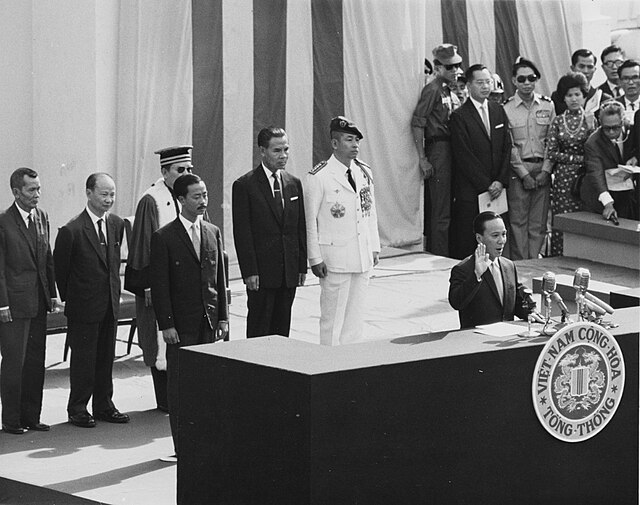Loading AI tools
Television channel From Wikipedia, the free encyclopedia
Vietnam Television (Vietnamese: Đài Truyền-hình Việtnam,[1][2] abbreviated THVN[3]), sometimes also unofficially known as the National Television (Đài Truyền-hình Quốc-gia[1]), Saigon Television (Đài Truyền-hình Sàigòn[1]) or Channel 9 (Đài số 9, THVN9), was one of two national television broadcasters in South Vietnam from February 7, 1966, until just before the Fall of Saigon on April 29, 1975. It was the first television broadcaster in Vietnam.[4]
 | |
| Country | South Vietnam |
|---|---|
| Broadcast area | South Vietnam, Cambodia |
| Headquarters | 9 Hồng Thập Tự[note 1] Avenue, Saigon |
| Ownership | |
| Owner | Radio-Television Public Broadcasting Centre National Government Joint General Staff |
| History | |
| Launched | 7 February 1966 |
| Closed | 29 April 1975 |
| Replaced by | SGTV (May 1, 1975) |
| Availability | |
| Terrestrial | |
| Over the air analog | Channel 9[note 2] |
THVN9 was operated by the Vietnamese Bureau of Television (Nha Vô-tuyến Truyền-hình Việtnam[1]), part of the General Department of Radio, Television, and Cinema (Tổng-cuộc Truyền-thanh Truyền-hình và Điện-ảnh[1]) in the Ministry of Propaganda.[5] Vietnam Television broadcast from the capital Saigon on channel 9 (4.5 MHz) in FCC-standard black and white.[4][6] However, from 1972, all important events were broadcast in color as standard.[7]
The other national broadcaster was the English-language Armed Forces Vietnam Network or NWB-TV on channel 11.[8] Both channels used an airborne transmission relay system from airplanes flying at the high altitudes, called Stratovision, as part of Operation Blue Eagle.
Vietnam Television Station (THVN) was established in 1965; its first broadcast was on February 7, 1966, at 6:58 pm, and the last one was at 11:58 pm on April 29, 1975. The first broadcast recorded images of Prime Minister Nguyễn Cao Kỳ and US ambassador Cabot Lodge.[9] Initially lasting for an hour,[10] the duration was later increased to two hours. On October 25, 1966, THVN's first above-ground establishment was finished.[11]
THVN was established at the same time as AFRTS (Armed Forces Radio Television Service), which was renamed as AFVN (Armed Forces Vietnam Network) in 1967.[9] THVN broadcast on band 9, while AFVN on frequency band 11.[12] AFVN broadcast the landing of Neil Armstrong on the Moon in 1969 for audiences in South Vietnam.[13]
Recording was first performed at the National Cinema Center No. 9 on Thi Sach Street.[14][15] In 1967, THVN was split into 2 separate departments - Cinema and Television.[16] THVN's headquarter was moved to 9 Hồng Thập Tự Avenue (now Nguyen Thi Minh Khai Street) - which later became the headquarter of the current Ho Chi Minh City Television.[17]
American television started in Vietnam on January 22, 1966 with tests on two channels. On February seventh, regular transmissions commenced with American programming on channel 11 and Vietnamese broadcasts on channel 9.
No permanent studio had been built, so three C-121 Super Constellation aircraft, known as Blue Eagles, were specially outfitted with film projectors and transmitters. A fourth Blue Eagle was radio only. It was used to relay audio of the 1965 World Series. Circling high over South Vietnam and transmitting U.S. TV programs on Channel 11, the Blue Eagles provided extended coverage to Americans who were arriving in increasing numbers. Steve Robbins was an organizer of Project Jenny which led to the Blue Eagle flights. He has a wealth of photos and information on his web site.
Later in 1966, a permanent TV station was completed at 9 Hong Thap Tu in Saigon. A huge antenna provided more reliable coverage. Hours were expanded and daily newscasts began. Concurrently, several detachments added television. A complete station was mounted in a van the size of a large semi trailer. The mountaintop locations of some detachments provided excellent coverage.
But unlike radio, AFVN television programming could not be fed directly from the Saigon key station to detachments. Wideband technology still was primitive in the late '60s. Programs on videotape and film were rotated among detachments using a weekly film flight and postal mail. In Saigon, sign-on was around noon daily while most detachments started transmissions around 4PM on weekdays and at noon on Saturday and Sunday. Troops watched favorite stateside series such as Bonanza, Mission Impossible, Gunsmoke, Laugh-In and Hawaii Five-O. Tape-delayed NFL football games and the ever-popular Roller Derby were other highlights. A soldier could even watch the series Combat on AFVN-TV. When Archie Bunker and All In The Family broke new ground, Archie's antics were seen weekly on AFVN-TV.
Television service continued until the American troop population dropped in 1971-72. Detachments were closed and AFVN-TV left the air in early 1973 as the Paris Peace Accords took effect. Most equipment and facilities were transferred to THVN, the South Vietnamese TV network.

Historical events in early 1975 were also broadcast by Saigon Television. The chaotic and bloody evacuation from the Central Highlands to Tuy Hoa along Highway 7, dubbed as the "Convoy of Tears" was broadcast on television - causing more terror for the people in the South.[20] This was followed by a live broadcast of the resignation speech of President Nguyễn Văn Thiệu on the evening of April 21, 1975.
On April 30, the TV crew of THVN9 went to the Independence Palace to broadcast for President Dương Văn Minh, but did not because around 7 am, Minh told everyone to leave.[5] A few hours later, the regime of the Republic of Vietnam ended.
The last broadcast of THVN9 was from 18:45 to 22:45 on April 29, 1975, the day before the Fall of Saigon. After the Fall of Saigon, THVN9 was handed over to the Viet Cong. Vietnam Television's final programming aired the evening of April 29, 1975.[21]
The next day, the station was reconstituted as Saigon Liberation Television Station (Đài Truyền-hình Sài-gòn Giải-phóng,[1] SGTV) with a live broadcast of South Vietnamese President Dương Văn Minh's surrender. However, SGTV became Ho Chi Minh City Television on May 1, 1975. The first broadcast (on channel HTV9 nowadays) was about the declaration of surrender by Dương Văn Minh.
On July 2, 1976, THVN was renamed as Ho Chi Minh City Television (HTV).
Ladies and gentlemen! This is Vietnam Television, broadcast on channel 9.[5][23]
— Start
Ladies and gentlemen! Vietnam Television's broadcast has ended.
We usually try our best to improve in the fields of information, education and entertainment, so be content.
Goodbye and see you again tomorrow, also on channel 9 of our Network.[5]— Final


| Time | Thursday, March 2, 1972 |
|---|---|
| 18:00 | Signal theme and saluting to the national flag, then the present of daily list |
| 18:05 | Short news |
| 18:10 | Civil defence |
| 19:00 | Announcement |
| 19:05 | Weekly news |
| 19:15 | New music to audiences |
| 20:00 | News |
| 20:30 | Mobilize voice |
| 21:00 | Criticize |
| 21:10 | Mobilize voice (continue) |
| 21:30 | Press review |
| 21:40 | International news |
| 21:50 | Drama Lady from Hatien of Southern Wind band |
| 22:30 | Exclusive news |
| 22:35 | Drama Lady from Hatien (continue) |
| 24:00 | Signal theme and saluting to the national flag, then saying goodbye |
List of featured programmes broadcast by the THVN9 :
Nearby permanent programmes, THVN9's directorate permitted all of South Vietnames citizens to have the right to "bidding" (đấu thầu) for buying the TV signal. Normally including officials, scholars, especially artists (vocalists, actors...). Languages included Vietnamese (primarily), Chinese, French, English, Khmer and Montagnard.
In divided Vietnam, the highlight of Vietnamese Catholicism and the Fátima messages was the visit of one of a few official statues of Our Lady of Fátima to South Vietnam in 1965. Originally scheduled for a three-month visit, this particular statue came from the Blue Army chapter in Australia and ended up traveling the country until 1967.[36] It was known as the “immaculate heart” statue because it puts her heart on the outside. This event was THVN (at the trial phase) lively recorded.
Nearby the media, THVN9 Network also sponsored the Young Music Festival[note 3][37] and Vietnam Film Day[note 4]. During the 1970s, Young Music Festival was the biggest cultural event in Asia and Oceania.[38][39][40][41] It has attracted many vocalists and bands from South Vietnam, Philippines, Hong Kong, Taiwan, Japan, South Korea, Australia, New Zealand and even the United States.[42] Their purpose was an anti-war exhortation and a supporting peace for whole world.[43]
On 27 April 1971, THVN9 reported Taiwanese singer Teresa Teng's tour. She performed at Lệ Thanh Theatre, Bát Đạt Grand Hotel in the capital Saigon for a month, then visited the Western Delta. Teng performed first hit No[note 5][44] of composer Nguyễn Ánh 9 by Japanese and Mandarin language.[45]
After 30 April 1975, total of videotapes were transferred to People's Army of Vietnam's Archives at No. 83 Lý Nam Đế street in Hanoi. However, some still existed by collectors. Many other copytapes were held by governments such as Australia, Canada, Denmark (Danish Vietnamese Association),[46] France (AFP), West Germany, Hong Kong, India, Japan, New Zealand, Philippines, South Korea (KBS), Taiwan, Thailand, United Kingdom (BBC), United States (AP). Besides, many of them were still used by modern Vietnamese filmmakers to do propaganda documentary ones.
From 2010, journalist Lê Quang Thanh Tâm has begun sharing some THVN9 tapes to Facebook and YouTube. Although clause as old reports of singers and actors.[47] In 2020, he has ever litigated Asia Entertainment Inc. (Trung tâm Asia) for a copyright theft when they registered as an owner on YouTube channel with these tapes.
In Los Angeles during the 1980s, some former technicians re-established THVN9 to broadcast news and dramas by Vietnamese language for service to the Vietnamese American community.[48] They registered a trademark as the Abroad-THVN Television Network (Vietnamese: Truyền-hình Việt-nam Hải-ngoại) to differentiate former THVN9 or Domestic-THVN.
According to MA Thành Lộc (born in 1961) about his childhood, father (PA Thành Tôn) often used a Vespa scooter for carrying his children to Saigonese avenue everynight. Because every South Vietnamese squares have always a television set for service freely poor people.[49] "A popular and familiar habit; a nice memory of my love city" – said him.[50]
During the Vietnam War in North Vietnam's localities, every municipal families who want to buy radio receivers and TV sets must registered at the police office of their ward or county. Moreover, areas as countryside, frontier and especially 17th parallel were forbidden. Illegal cases could came the jail or revamped learned many years. So this enactment was like a resistance for all efforts of their enemy or, as called in North Vietnamese documents, as the "propagandas of our enemies" (tuyên truyền của thế lực thù địch).
However, by the recall of author Vương Trí Nhàn to RFI (Thụy Khuê's voice programme) about 2000s, many cultural & arts organizations, military and security agencies in Hanoi be still licensed to observe South Vietnamese radio and television, especially THVN9.[51] By singer Ái Vân, she knew singing voice of Út Trà Ôn, Ngọc Giàu, Lệ Thủy, Út Bạch Lan, Thành Được... from the 1960s when was a post-war.[52]
Seamless Wikipedia browsing. On steroids.
Every time you click a link to Wikipedia, Wiktionary or Wikiquote in your browser's search results, it will show the modern Wikiwand interface.
Wikiwand extension is a five stars, simple, with minimum permission required to keep your browsing private, safe and transparent.